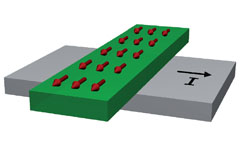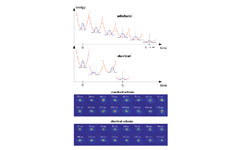Accueil
Optimization of MEOP experiment performed at elevated 3He pressures (Vol. 42, No. 3)
 (a) Reshape of the gaussian pump laser beam into the annular profile using
a pair of axicons, (b) Photograph of the rf discharge plasma afterglow in a
transversal plane of helium cell, (c) Steady-state nuclear polarization of 3He gas
vs pressure for two laser beam profiles.
(a) Reshape of the gaussian pump laser beam into the annular profile using
a pair of axicons, (b) Photograph of the rf discharge plasma afterglow in a
transversal plane of helium cell, (c) Steady-state nuclear polarization of 3He gas
vs pressure for two laser beam profiles.
It was demonstrated about fifteen years ago that hyperpolarized 3He gas can be used as an inhaled contrast agent in Magnetic Resonance Imaging (MRI) of human lungs. Since then, the technique has proved successful in anatomical and dynamic ventilation studies, which are not feasible by the standard proton MRI. One of the methods to obtain 3He gas of high polarization is Metastability Exchange Optical Pumping (MEOP),which is usually performed at low operating pressure of 1 mbar and at low magnetic field of 1 mT. Recently it has been shown that the MEOP method can be also performed at elevated 3He gas pressure, up to 260 mbar, provided it is performed at high magnetic field of 1.5 T or higher. Under these operating conditions, one of the factors that limits the efficiency of the method is an inhomogeneous density distribution of metastable state atoms produced by the RF discharge in the optical pumping cell (Fig.b). The paper shows how the situation can be improved by matching the spatial profile of the pumping laser beam to the distribution of metastable atoms. It is achieved by using a pair of axicons to produce an annular, instead of conventional Gaussian beam profile (Fig.a). The obtained nuclear polarization of 3He gas was up to 60% higher for pressures above 67 mbar (Fig.c). This result opens the possibility of producing large quantities of highly polarized 3He gas in a compact polarizer working in highmagnetic field of medical MRI scanner.
Optimization of the pumping laser beamspatial profile in
the MEOP experiment performed at elevated 3He pressures
T. Dohnalik et al. Eur. Phys. J. Appl. Phys. 54, 20802 (2011)
[Abstract]
Spin-charge locking and tunnelling into a helicalmetal (Vol. 42, No. 3)
 a ferromagnet (green) that is coupled to a topological insulator (grey) such
that electrons can tunnel between the two materials. it is found that a current
flowin the surface states of the topological insulator strongly modifies the
tunnelling current.
a ferromagnet (green) that is coupled to a topological insulator (grey) such
that electrons can tunnel between the two materials. it is found that a current
flowin the surface states of the topological insulator strongly modifies the
tunnelling current.
Spintronics aims at exploiting the electron spin for new device functionalities. In recent years a new spintronic paradigm, based on the spin-orbit interaction, has been proposed aiming to gain spin control by electric fields. In this respect, topological insulators (TI) appear as a very promising opportunity. At the surface of aTI gapless excitations occur with extraordinarily strong spinorbit coupling: a given surface momentum is associated with a single spin direction, such that the states on the Fermi surface have a well-defined helicity.
In this paper we present a theoretical study of the dynamics of the electrons moving on the surface of a three-dimensional TI, i.e. in a two-dimensional helical metal (HM). When the HM is brought into contact with a ferromagnet, there arises an unconventional magnetoresistance. The origin of the effect is the spin-orbit coupling: since the electron momentum is connected to a single spin state, a current flow creates a nonequilibrium spin polarization. This current-induced spin polarization increases or decreases the spin dependent voltage difference between the helicalmetal and themajority or minority carriers in the FM and thus modifies the tunnelling current. By reversing the flow of the current in the helical metal the two spin species exchange their role. In the ideal case the tunnelling current between the FM and the HM can be switched on and off depending on the relative orientation of the magnetization of the FM with respect to the direction of the current flow in the HM.
Spin-Charge Locking and Tunnelling into a HelicalMetal
P. Schwab, R. Raimondi and C. Gorini, EPL 93, 67004 (2011)
[Abstract]
Statistical physics approach to graphical games (Vol. 42, No. 3)
 network of agents playing a graphical game. The payoff matrices depend both
on the local neighbourhoods and on some aggregate signal. The equilibriums
are reached by exchanging localmessages and their overall geometrical structure
can be analyzed by statistical physics techniques.
network of agents playing a graphical game. The payoff matrices depend both
on the local neighbourhoods and on some aggregate signal. The equilibriums
are reached by exchanging localmessages and their overall geometrical structure
can be analyzed by statistical physics techniques.
A graphical game is a mathematical framework to analyse strategic interactions among self-interested agents who play only with their neighbours in a graph. It usually makes predictions in terms of equilibrium concepts, chief among which is the Nash equilibrium: a configuration of strategies where nobody has a unilateral incentive to deviate. The problem of finding a Nash equilibrium is believed to be computationally intractable. In this work we show how to use methods from statistical physics of disordered systems to develop efficient and fully distributed (approximate) algorithms to tackle this problem. Furthermore, motivated by the recent interest in the study of the interplay between local and global interactions in multi-agent systems, we propose a new compact representation of games that extends over graphical games to deal conveniently with a global interaction and show how to extend the methods to this new case. We also derive the phase diagrams of different ensembles of random graphical games and study the structure of the corresponding space of solutions. Evidence of HARD/EASY phase transitions is found in some cases.
Statistical physics approach to graphical games: local and global interactions
A. Ramezanpour et al., Eur. Phys. J. B 80, 555 (2011)
[Abstract]
Shortcut to adiabaticity with ultracold atoms (Vol. 42, No. 3)
 Top: Principle of
shortcut to adiabaticity.
The blue and red
curves represent the
BEC wave function and
trapping potential
respectively. below:
comparison of BEC
excitations produced
by standard and shortcut
decompressions.
Top: Principle of
shortcut to adiabaticity.
The blue and red
curves represent the
BEC wave function and
trapping potential
respectively. below:
comparison of BEC
excitations produced
by standard and shortcut
decompressions.
Adiabatic transformations are widely used in physics, and for instance are at the heart of the manipulation of quantum states. In such transformations, the Hamiltonian should typically vary slowly with time, such that the system always remains close to equilibrium. The drawback is the long transition time, which in some situations becomes unpractical due to finite lifetime or coherence time of the state under study. Alternatively, a "shortcut to adiabaticity" is a specifically designed temporal trajectory of the Hamiltonian, which connects the initial to the final state in a shorter time. The system is out of equilibrium during the transition, but the final state is identical to that obtained via an adiabatic transition (Fig., upper panel).
We have applied this strategy for the first time, to rapidly decompress an interacting Bose-Einstein condensate (BEC) held in a magnetic trap. Reducing the trap confinement also shifts the cloud vertically by a large amount, due to gravity. We implemented a 30ms-long trajectory designed for a 10-fold reduction of the trap frequency. Because of experimental imperfections, the final state we obtained is not an equilibrium one. However, we were able to demonstrate a large reduction of BEC excitations (dipole and breathing modes) when comparing the shortcut to other standard decompression schemes (Fig., lower panel). This trajectory was also shown to work for a thermal cloud with negligible interactions, hinting at the broad range of application of this technique.
Shortcut to adiabaticity for an interacting Bose-Einstein condensate
J.-F. Schaff et al., EPL 93, 23001 (2011)
[Abstract]







